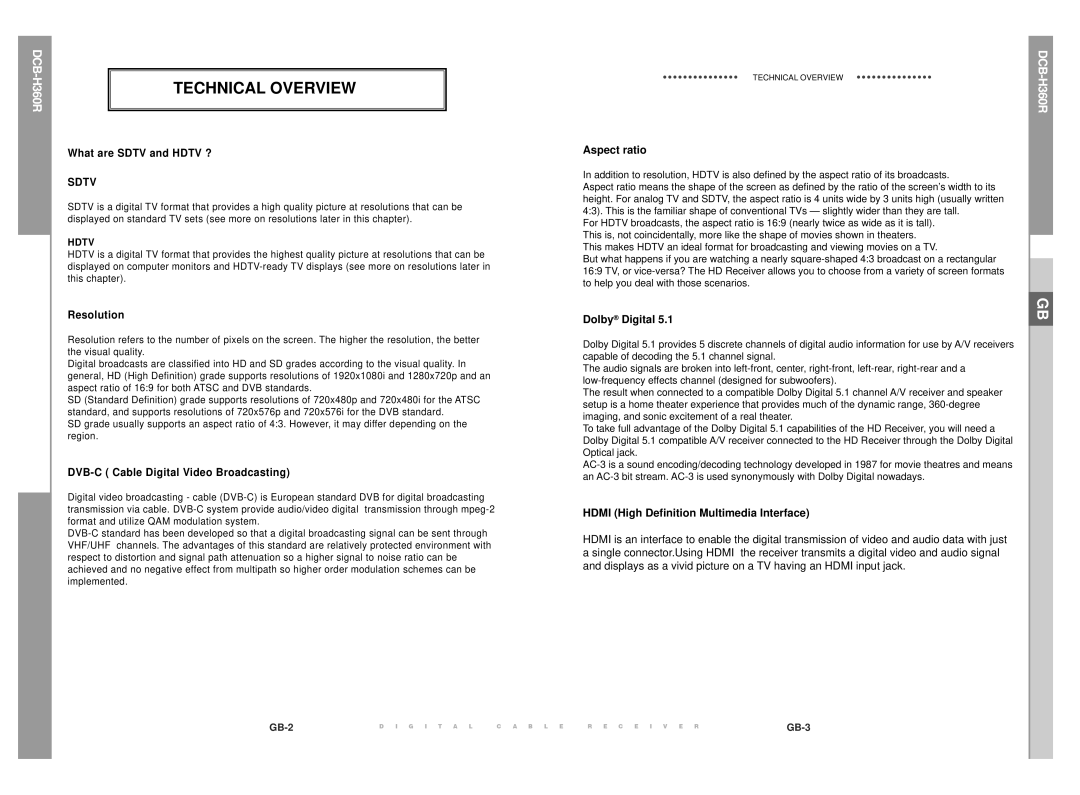
TECHNICAL OVERVIEW
TECHNICAL OVERVIEW
What are SDTV and HDTV ?
SDTV
SDTV is a digital TV format that provides a high quality picture at resolutions that can be displayed on standard TV sets (see more on resolutions later in this chapter).
HDTV
HDTV is a digital TV format that provides the highest quality picture at resolutions that can be displayed on computer monitors and
Aspect ratio
In addition to resolution, HDTV is also defined by the aspect ratio of its broadcasts.
Aspect ratio means the shape of the screen as defined by the ratio of the screen’s width to its height. For analog TV and SDTV, the aspect ratio is 4 units wide by 3 units high (usually written 4:3). This is the familiar shape of conventional TVs — slightly wider than they are tall.
For HDTV broadcasts, the aspect ratio is 16:9 (nearly twice as wide as it is tall). This is, not coincidentally, more like the shape of movies shown in theaters. This makes HDTV an ideal format for broadcasting and viewing movies on a TV.
But what happens if you are watching a nearly
Resolution
Resolution refers to the number of pixels on the screen. The higher the resolution, the better the visual quality.
Digital broadcasts are classified into HD and SD grades according to the visual quality. In general, HD (High Definition) grade supports resolutions of 1920x1080i and 1280x720p and an aspect ratio of 16:9 for both ATSC and DVB standards.
SD (Standard Definition) grade supports resolutions of 720x480p and 720x480i for the ATSC standard, and supports resolutions of 720x576p and 720x576i for the DVB standard.
SD grade usually supports an aspect ratio of 4:3. However, it may differ depending on the region.
DVB-C ( Cable Digital Video Broadcasting)
Digital video broadcasting - cable
D I G I T A L | C A B L E |
Dolby® Digital 5.1
Dolby Digital 5.1 provides 5 discrete channels of digital audio information for use by A/V receivers capable of decoding the 5.1 channel signal.
The audio signals are broken into
The result when connected to a compatible Dolby Digital 5.1 channel A/V receiver and speaker setup is a home theater experience that provides much of the dynamic range,
To take full advantage of the Dolby Digital 5.1 capabilities of the HD Receiver, you will need a Dolby Digital 5.1 compatible A/V receiver connected to the HD Receiver through the Dolby Digital Optical jack.
HDMI (High Definition Multimedia Interface)
HDMI is an interface to enable the digital transmission of video and audio data with just a single connector.Using HDMI the receiver transmits a digital video and audio signal and displays as a vivid picture on a TV having an HDMI input jack.
R E C E I V E R |
GB
